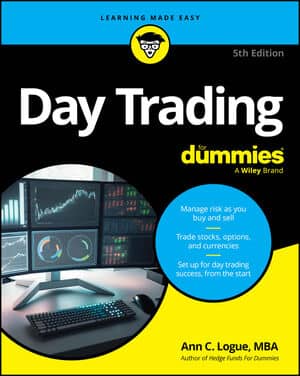Expected return, the happy number, has a not-so-happy counterpart called the probability of ruin. As long as there is some probability of loss, no matter how small, there is some probability that you can lose everything when you're trading. How much you can lose depends on how large each trade is relative to your account, the likelihood of each trade having a loss, and the size of the losses as they occur.
The following figure shows the math for finding R, the probability of ruin.
A is the advantage on each trade. That’s the difference between the percentage of winning trades and the percentage of losing trades. In the earlier expected return example, trades win 60% of the time and lose 40% of the time. In that case, the trader’s advantage would be:
60% – 40% = 20%
C is the number of trades in an account. Let’s assume that we’re dividing the account into ten equal parts, with the plan of making ten trades today. The probability of ruin today is 1.7%.
Now, 1.7% isn’t a high likelihood of ruin, but it isn't zero, either. If your advantage is smaller, if the expected loss is larger, or if the number of trades is fewer, then the likelihood of ruin becomes even higher.
The following table shows you the relationship between the trader’s advantage (the far left column), number of trades (along the top), and the corresponding probability of ruin, rounded to the nearest percentage.
| 1 | 2 | 3 | 4 | 5 | 6 | 7 | 8 | 9 | 10 | |
|---|---|---|---|---|---|---|---|---|---|---|
| 2% | 96% | 92% | 89% | 85% | 82% | 79% | 76% | 73% | 70% | 67% |
| 4% | 92% | 85% | 79% | 73% | 67% | 62% | 57% | 53% | 49% | 45% |
| 6% | 89% | 79% | 70% | 62% | 55% | 49% | 43% | 38% | 34% | 30% |
| 8% | 85% | 73% | 62% | 53% | 45% | 38% | 33% | 28% | 24% | 20% |
| 10% | 82% | 67% | 55% | 45% | 37% | 30% | 25% | 20% | 16% | 13% |
| 12% | 79% | 62% | 49% | 38% | 30% | 24% | 18% | 15% | 11% | 9% |
| 14% | 75% | 57% | 43% | 32% | 24% | 18% | 14% | 10% | 8% | 6% |
| 16% | 72% | 52% | 38% | 27% | 20% | 14% | 10% | 8% | 5% | 4% |
| 18% | 69% | 48% | 34% | 23% | 16% | 11% | 8% | 5% | 4% | 3% |
| 20% | 67% | 44% | 30% | 20% | 13% | 9% | 6% | 4% | 3% | 2% |
The bigger the edge and the more trades you can make, the lower your probability of ruin. Now, this model is a simplification in that it assumes that a losing trade goes to zero, and that’s not always the case. In fact, if you use stops (automatic buy and sell orders), you should never have a trade go to zero. But you can see steady erosion in your account that will make it harder for you to make money. Hence, probability of ruin is a useful calculation that shows whether you will lose money in the long run.
The more trades you can make with your account, the lower your probability of ruin. That’s why money management is a key part of risk management.

